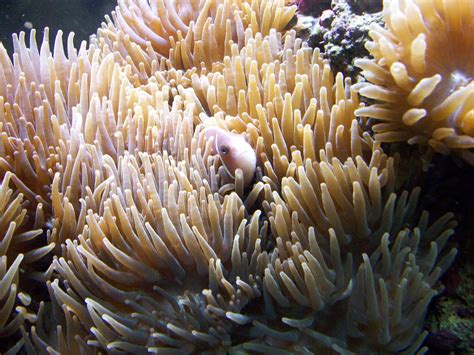How To Get Clownfish To Host Anemone
Ronan Farrow
Mar 31, 2025 · 3 min read

Table of Contents
How to Get Clownfish to Host an Anemone: A Comprehensive Guide
Finding a happy, symbiotic relationship between clownfish and anemones is a rewarding experience for any marine aquarium enthusiast. However, successfully introducing clownfish to an anemone isn't always guaranteed. This guide will walk you through the process, covering essential steps to increase your chances of success.
Understanding the Symbiotic Relationship
Before diving into the specifics, it's crucial to understand the nature of the relationship between clownfish and anemones. This isn't simply a case of putting two creatures together; it's a complex symbiotic relationship built on mutual benefit.
- Clownfish Protection: The anemone's stinging nematocysts provide a safe haven for the clownfish, protecting them from predators.
- Anemone Nutrition: Clownfish contribute to the anemone's well-being by bringing in food scraps and potentially cleaning it.
- Mutualism: This is a mutually beneficial relationship. Both the clownfish and anemone benefit from the co-existence.
Choosing the Right Anemone and Clownfish
The selection of appropriate species is paramount. Not all clownfish and anemones are compatible. Research is key!
Selecting the Anemone:
- Species Compatibility: Research which anemone species are known to host your chosen clownfish species. Some popular choices include Maxi-Mini anemones, Bubble-tip anemones, and Carpet anemones. Each has varying requirements for water parameters and lighting.
- Anemone Health: Always ensure the anemone is healthy and vibrant before introducing it to your tank. Look for signs of good health, such as full, plump tentacles and active movement. A stressed or unhealthy anemone is less likely to host.
- Tank Size: Choose an anemone appropriately sized for your tank. Overly large anemones can overshadow the tank and potentially stress other inhabitants.
Selecting the Clownfish:
- Species Compatibility: This cannot be stressed enough. Certain clownfish species are more likely to host certain anemone species. Research carefully to ensure a good match.
- Clownfish Age: Juvenile clownfish are generally more likely to host an anemone than adults. Adults may already be accustomed to their environment and less inclined to adopt a new host.
- Clownfish Health: Ensure your clownfish is healthy and free from disease. A stressed or sick clownfish may not be receptive to hosting.
Acclimating Both Anemone and Clownfish
Proper acclimation is essential to reduce stress and improve the chances of a successful introduction. Follow established acclimation procedures for both the anemone and the clownfish.
- Slow Introduction: Gradually acclimate both the anemone and clownfish to the tank's water parameters to prevent shock.
- Water Parameters: Ensure consistent water parameters (temperature, salinity, pH) between the acclimation container and the main tank.
Introducing the Clownfish to the Anemone
This process requires patience and observation. Don't force the interaction!
- Placement: Position the anemone in a suitable location within the tank, providing ample light and flow.
- Observation: Observe the clownfish's behavior. Some clownfish will immediately investigate the anemone, while others may take days or even weeks.
- No Forcing: Avoid trying to force the clownfish into the anemone. This will only stress both creatures.
- Patience is Key: Be patient and allow the clownfish to approach the anemone at its own pace.
Maintaining Optimal Tank Conditions
Maintaining consistent, high-quality water parameters is essential for a thriving symbiotic relationship.
- Water Quality: Regularly test and maintain optimal water parameters.
- Water Changes: Regular water changes are crucial for removing waste and maintaining water quality.
- Filtration: Ensure your filtration system is adequate for the tank's size and inhabitants.
- Lighting: Provide appropriate lighting for both the anemone and the clownfish.
Troubleshooting
If the clownfish isn't hosting the anemone after a reasonable period, there could be several reasons:
- Incompatible Species: The clownfish and anemone species may not be compatible.
- Stress: Both the clownfish and anemone may be stressed due to poor water quality or tank conditions.
- Poor Health: Check for signs of illness or stress in both the clownfish and anemone.
By carefully following these steps and maintaining a healthy tank environment, you significantly increase your chances of successfully establishing a harmonious relationship between your clownfish and anemone. Remember, patience and observation are key to success!
Featured Posts
Also read the following articles
| Article Title | Date |
|---|---|
| How To Date Ka Bar Knives | Mar 31, 2025 |
| How To Get Rid Of Fluid After Liposuction | Mar 31, 2025 |
| How To Fix Electrical Arcing | Mar 31, 2025 |
| How To Get A Non Vbv Cc | Mar 31, 2025 |
| How To Get Rid Of Big Headed Ants | Mar 31, 2025 |
Latest Posts
-
Mother Half Pipe This Is How I Roll
Apr 03, 2025
-
Mommed Pregnancy Test How Early
Apr 03, 2025
-
Mary Oliver How I Go To The Woods
Apr 03, 2025
-
Macon Controls Thermostat How To Use
Apr 03, 2025
-
Lucid Boost Vape How To Turn On
Apr 03, 2025
Thank you for visiting our website which covers about How To Get Clownfish To Host Anemone . We hope the information provided has been useful to you. Feel free to contact us if you have any questions or need further assistance. See you next time and don't miss to bookmark.
